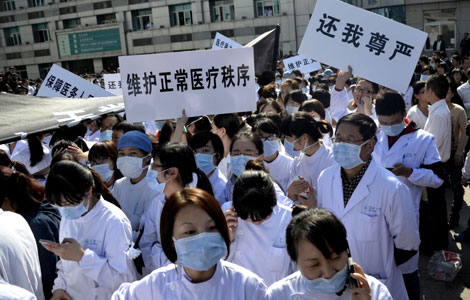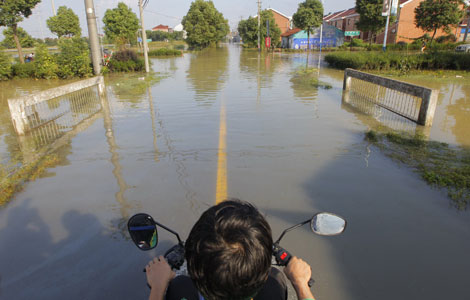Li urges farmers to plant more in 2014
Updated: 2013-11-05 00:51
By ZHAO YINAN in Fuyuan, Heilongjiang and ZHONG NAN in Beijing (China Daily)
|
|||||||||||
Premier Li Keqiang has encouraged farmers in Heilongjiang province to plant more crops next year to ensure their own prosperity as well as the nation's food safety.
"As the largest grain producer, Heilongjiang is embracing a good harvest this year in the wake of a devastating flood. The province showed a strong capability to fight against natural disasters as well as its great potential for grain output," Li said during a visit to the province on Monday.
Li said grain is like a golden mountain, which lays the foundation of the nation, as he visited a local grain depot in Nongqiao township, in Fuyuan county.
"Standing on top of the grain, I feel a sense of reassurance," he said.
Li arrived in Fuyuan on Monday to inspect grain production and the state of flood-stricken residents as they resettle in the area.
Fuyuan and neighboring Tongjiang were both hit by devastating floods over the summer, damaging crops and creating billions of yuan in economic losses.
Liu Jinfu, 47, and his family were hit hard by the disaster. He said his cornfield yielded next to nothing this year because of the flood, which cost his family nearly 200,000 yuan ($32,790) in economic losses.
Li, sitting in Liu's traditional adobe home in rural China, encouraged the farmer to replant crops after floodwaters receded. He also urged local governments to ensure that flood-stricken residents have a safe and warm winter.
Heilongjiang, home to large areas of fertile land, is one of the country's major grain producers.
Wang Xiankui, Party chief of the province, said the grain output is expected to reach 65 billion kg this year, despite the flooding.
Li Guoxiang, deputy director of the rural development institute at the Chinese Academy of Social Sciences in Beijing, said the expected output is possible because farmland in northern China has better natural conditions than those in the south.
He said China's major grain-producing areas used to be in irrigated farmlands in the South.
"Farmers ensured their grain output by improving unit area yield. This fundamental method contributed to almost 80 percent of China's total grain output in 2012," he said.
However, this method isn't sustainable and a great deal of farmland has already reached its maximum production level of various crops, according to a study released by the Chinese Academy of Agricultural Sciences in September.
"In contrast, almost half of China's farmland is located in the North, especially in the Northeast, where the land doesn't necessarily depend on heavy irrigation. The area has strong potential in raising the gain output in rice, corn and soybeans," said Ding Shengjun, a senior researcher at the Academy of the State Administration of Grain.
Ding said the dry farmland, mainly located in northeast, northwest and southwest regions, are rich in sunshine and have distinct temperature differences between day and night.
"This provides favorable conditions to improve grain output," he said.
Contact the writers at zhaoyinan@chinadaily.com.cn and zhongnan@chinadaily.com.cn
Related Stories
Innovation should drive reform, says Premier Li Keqiang 2013-09-18 07:48
Li Keqiang: China will stay the course on sustainable growth 2013-09-09 19:45
Li Keqiang: A man who puts people first 2013-05-17 17:48
Today's Top News
Chinese Premier Li seeks point of balance
Reform roadmap before key meeting
Intel leaks proved justified: Snowden
Cooperation needed in terror fight
Beijing to further boost visa-free stay
Shenzhou X crew awarded for outstanding service
US to file murder complaint against LAX shooter
China's non-manufacturing PMI rises in October
Hot Topics
Lunar probe , China growth forecasts, Emission rules get tougher, China seen through 'colored lens', International board,
Editor's Picks

|

|

|

|

|

|





